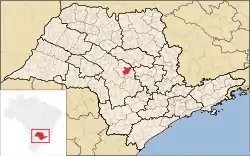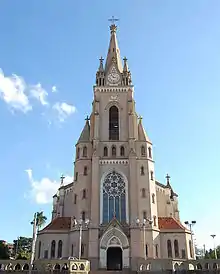Jaú
Jaú is a municipality in the center of the state of São Paulo, in Brazil. The population is 151,881 (2020 est.) in an area of 687 square kilometres (265 sq mi).[2] The elevation is 522 metres (1,713 ft). The city takes its name from the native fish species jau.
Jaú | |
|---|---|
 | |
 Flag  Coat of arms | |
 Location in São Paulo state | |
 Jaú Location in Brazil | |
| Coordinates: 22°17′45″S 48°33′28″W | |
| Country | Brazil |
| Region | Southeast |
| State | São Paulo |
| Government | |
| • Mayor | Jorge Ivan Cassaro (2021-2024) (PSD) |
| Area | |
| • Total | 687 km2 (265 sq mi) |
| Elevation | 541 m (1,775 ft) |
| Population (2020 [1]) | |
| • Total | 151,881 |
| • Density | 220/km2 (570/sq mi) |
| Time zone | UTC-03:00 (BRT) |
| • Summer (DST) | UTC-02:00 (BRST) |
| Website | www |
History

The history of the city goes back to 1853, when a group of people decided to settle and found a village. Not until 1889, however, did it achieve the status of town. Its most widely known inhabitant is João Ribeiro de Barros, the first man to travel from Europe to South America by plane, in 1927, 23 days before Charles Lindbergh's flight.
Economy
Jaú is located in a tropical weather region, known for its very fertile lands, which were once called "terra roxa" (purple land). The city is known as the national capital of female shoes, which are exported to the whole world.
Sports
Esporte Clube XV de Novembro is a traditional sport club of the town, founded in 1924. The club plays its home matches at Estádio Zezinho Magalhães. Jaú is also the birthplace of freestyle swimmer Renata Burgos, who represented Brazil at the 2004 Summer Olympics in Athens, Greece.